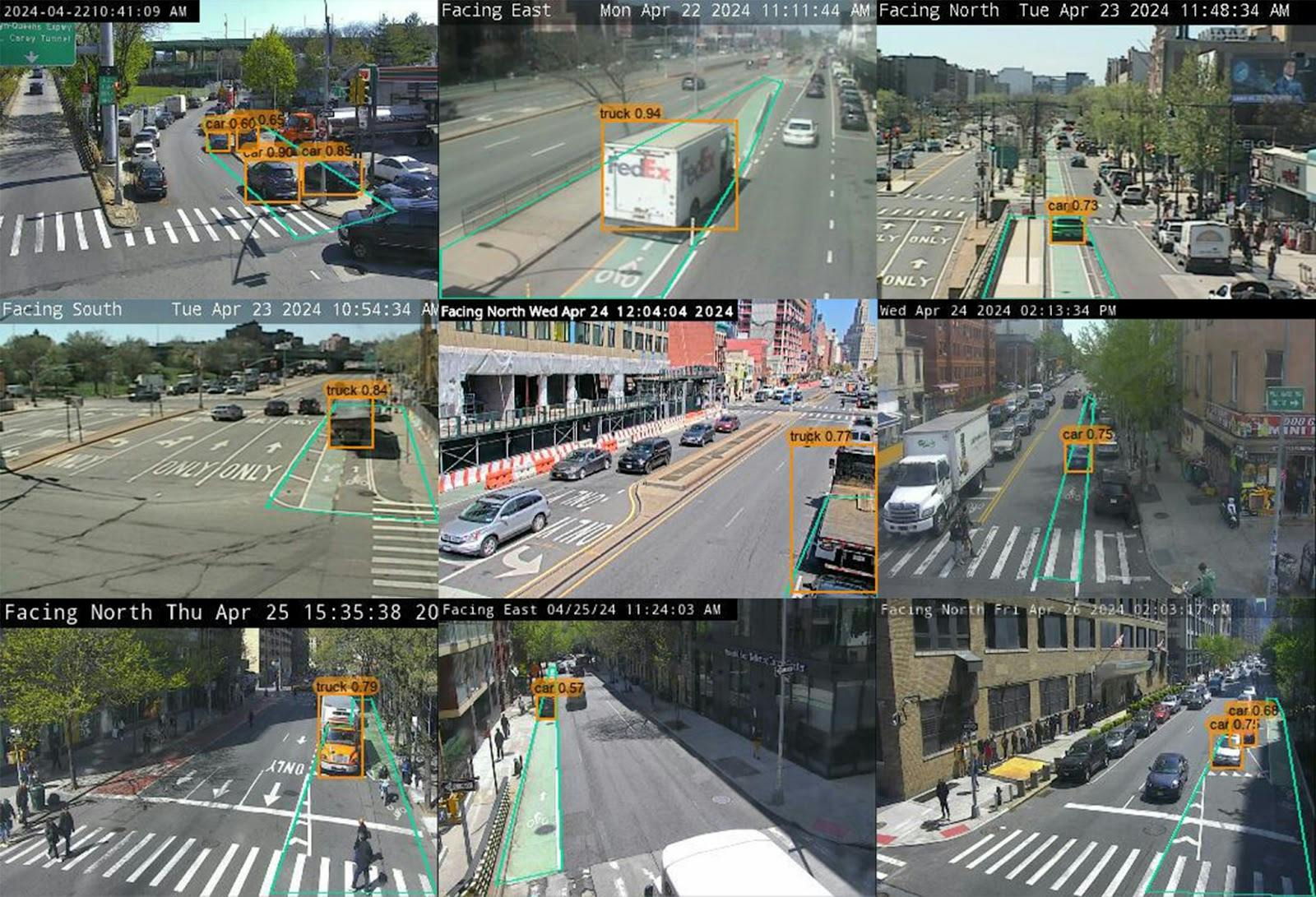An analysis that uses AI to detect violations shows the police closing complaints with impossible speed.
In New York City, chaos has a favorite parking spot: your local bike lane. While endless debates rage over the city's descent into disorder, the most visible — and preventable — symbol of urban dysfunction sits illegally parked on countless streets.
Our recent study puts numbers behind this daily disorder. In the first systematic analysis of how the NYPD handles illegal parking complaints, we uncovered a troubling pattern: Enforcement is sparse, and complaints are often dismissed with impossible speed, all at a time when data shows citizens are increasingly concerned about the issue.
Over the course of a week in April we monitored 21 city-owned camera feeds with custom-built software that uses AI to detect illegal parking. The cameras were chosen based on having a clear view of a spot that was unambiguously off limits to cars, such as bike lanes, fire hydrants and painted no-standing zones. When the program detected illegal parking, it automatically filed a complaint to 311, the city’s hotline for non-emergency services, which was then forwarded to the NYPD.
Our system generated 588 complaints and found that in more than 52% of the cases when the police closed a complaint, there were still vehicles parked illegally. We also found a pattern of complaints closed impossibly fast. The police resolved about a third in less time than they took to respond to the most critical 911 calls, such as shots fired or assault in progress. About 9% were closed in less than a minute, and the fastest was open for just 14 seconds.

These figures echo previous findings from a small Department of Investigation report on the NYPD’s response to 311 complaints about parking placard misuse where police failed to respond half the time. The report concluded that “there is a need for more transparency and accountability in the 311-response process on the part of NYPD.” There have been multiple documented cases of officers harassing citizens who file illegal parking complaints, and during our study officers from two precincts sent emails to us attempting to discourage filing complaints.
This was not the promise when 311 went online over 20 years ago.
“Getting help from the city shouldn’t be a chore,” then-mayor Michael Bloomberg said when he introduced the 311 system in 2003. “311 gives the NYPD the tools to rapidly address quality of life complaints,” he added, comparing the data to CompStat, a system often extolled for its role in addressing record crime levels in the 90s. Two decades later, this vision of responsive city services has failed to materialize when it comes to illegal parking.
At its core, this systematic failure of enforcement reveals a deeper crisis of governance. How do city officials allocate resources if the data that underlies those decisions is tainted? When police close complaints for reasons that do not match the facts on the ground, it sabotages data-driven governance, on top of all the physical ailments illegal parking creates.
These findings also highlight the issue of how we want to collectively use public space. There are about 3 million free parking spaces in the five boroughs, according to a 2019 estimate from then-Department of Transportation commissioner Polly Trottenberg. And despite this, our study found delivery vehicles taking over bike lanes and turning lanes into impromptu logistics hubs for hours at a time. At one location on the Upper East Side over multiple days, a brown box truck received as many as 11 complaints from our system. In all of these cases, the police closed the complaint with the resolution description “action was not necessary.”
There are several immediate fixes to increase accountability and enforcement. A simple technological fix could require police officers to register a GPS location and provide photo evidence when responding to these complaints, with this information made publicly available along with existing 311 records. Additionally, parking tickets issued in response to a 311 complaint should include information that allows them to be linked to a complaint. Lastly, the responsibility of responding to illegal parking complaints should be transferred to traffic enforcement officers, rather than police on patrol.
A more ambitious solution would be to implement a version of the automated system described in our study. Cameras designed to detect illegal parking and issue tickets automatically, similar to the current speed and red light camera programs, or MTA’s Automated Camera Enforcement for bus lanes, would significantly free up police resources and provide consistent enforcement. These programs have been proven effective and expanded in recent years. Cameras to monitor parking could be permanently affixed in certain hotspots and also be deployed on a temporary basis to discourage illegal parking citywide.
The lax enforcement we've documented fuels the city’s entrenched car culture — a culture exacerbated by the Adams administration blocking essential street safety redesigns and Governor Hochul’s recent cancellation of congestion pricing. As car ownership has surged by 12.1% between 2012 and 2021, traffic deaths have climbed to record highs since Vision Zero began in 2014. Unless our streets are made safe for cycling, walking and public transit, these outcomes will only worsen.
Every illegally parked car represents a choice: between order and chaos, between public safety and private convenience, between the city we want and the city we have. The technology exists to solve this problem. The only question remaining is whether we have the political will to use it.